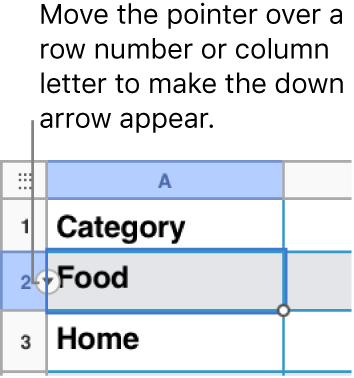
Add or change rows and columns in Keynote for iCloud
You can add, delete, and rearrange rows and columns in a table. There are three types of rows and columns:
Body rows and columns: Body cells contain the table data, and appear below the header row(s) and to the right of the header column(s).
Header rows and columns (if any): These appear at the top and left side of the table. They usually have a different background color from the body rows, and they’re typically used to identify what the row or column contains. Data in header cells isn’t used in calculations, but the text in a header cell can be used in formulas to refer to the entire row or column.
A table can have up to five header rows and five header columns.
Footer rows (if any): These appear at the bottom of a table. A table can have up to five footer rows.

Add or remove body rows and columns
You can add rows or columns to the bottom or right edges of a table, or insert new rows or columns between the existing ones.
Click the table, then do any of the following:
Insert or delete a row or column within the table: Move the pointer over a row number or column letter, click the arrow, then choose an item.

Add or delete rows or columns at the edge of the table: To add rows, click the row handle in the bottom-left corner of the table, then click the arrows to increase or decrease the number of rows. To add columns, click the column handle in the top-right corner of the table, then click the arrows to increase or decrease the number of columns.
Note: You can use these controls to delete only empty rows or columns.
Insert multiple rows or columns at once: Anywhere in the table, select a number of rows or columns equal to the number of rows or columns you want to insert, click the arrow next to a selected row number or column letter, then choose to add rows above or below, or add columns before or after the current selection.
Delete multiple rows or columns at once: Select the rows or columns you want to delete, click the arrow next to a selected row number or column letter, then choose Delete Selected Rows or Delete Selected Columns.
Add and remove header rows, header columns, or footer rows
Adding header rows, header columns, or footer rows converts existing rows or columns into headers or footers. For example, if you have data in the first row of a table and you add a header row, the first row is converted to a header row that contains the same data.
Click the table.
Click Table at the top of the Format sidebar on the right.
Click the Headers & Footer pop-up menus, then choose a number.
Move rows or columns
Click the table.
Select one or more rows or columns, then do one of the following:
Move columns to a new location in the table: Drag to the right or left of another column.
Move rows to a new location in the table: Drag above or below another row.
Resize rows or columns
Click the table.
Do one of the following:
Automatically resize to fit the content: Move the pointer over the row number or column letter, click the arrow that appears, then choose Fit Height to Content or Fit Width to Content.
Resize freely: Hold the pointer on the line below the row number, or on the line to the right of the column letter, until the pointer changes shape (it becomes a line with arrows extending from both sides). Drag in the direction you want to resize.